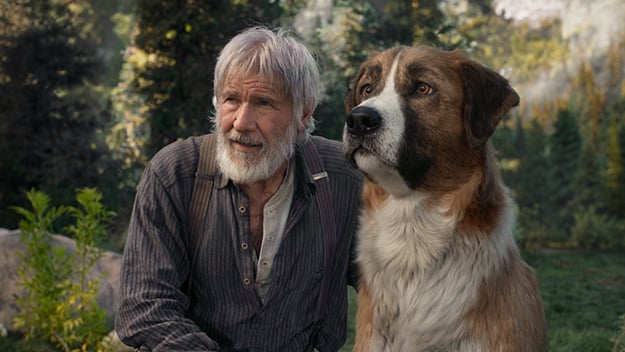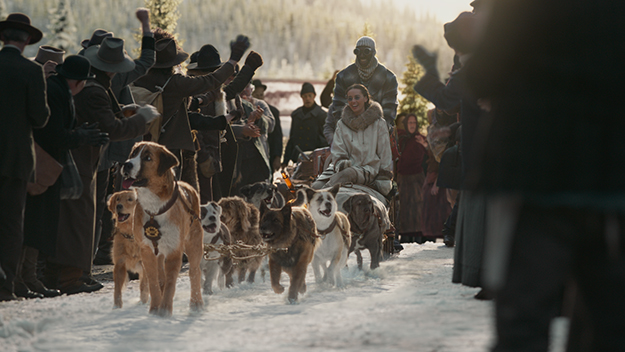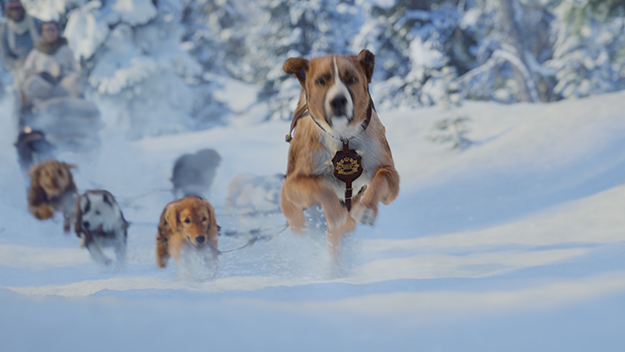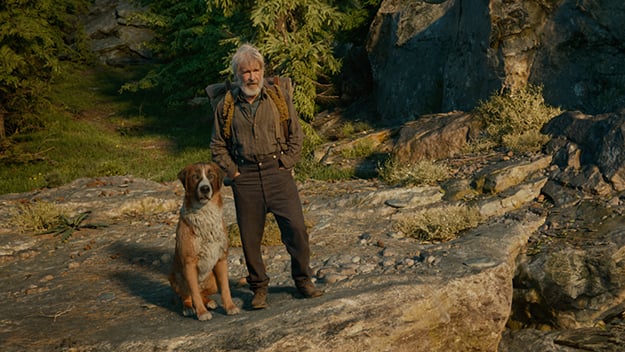Deep Focus: The Call of the Wild

The Call of the Wild (Chris Sanders, 2020)
This flimsy adaptation of Jack London’s 1903 Klondike Gold Rush classic, the first film to sport the “20th Century Studios” label (without the “Fox”), offers a soft-edged rendering of a St. Bernard/Scotch shepherd mix reverting to a wolf-like state. Though it’s packed with CGI, it plays like any old mid-level, live-action Disney movie. And now it actually is one, since Disney bought the studio.
Screenwriter Michael Green and director Chris Sanders broadly follow London’s portrait of the heroic Buck as he’s dognapped from his cushy Santa Clara, California home to pull sleds in the Yukon. This cosseted animal must submit to the rule of force, administered first with whips and bludgeons, then with the snapping jaws of huskies. The film’s wishy-washy attitude toward London’s vision of a dog-kill-dog universe turns the mid-section from a harrowing crucible into a canine fantasia. When a fetching white timber wolf sets her sights on manly Buck, she could be singing, “When I’m calling you/oo-oo-oo-oo/Will you answer to?—oo-oo-oo-oo….” What Buck responds to in the end is more like “Indian Love Call” than The Call of the Wild.
The meat of the action starts when Buck lands in harness to a righteous couple, Perrault (Omar Psy) and Francoise (Cara Gee), who carry the mail to boom towns and mining camps. Buck learns the satisfaction of hard work and defeats the shifty top dog to become team leader. Early on, Buck and a grizzled fellow named Jack Thornton (Harrison Ford) fall in love at first sight. After the government reassigns the mail carriers, the dog team ends up with a trio of arrogant novice prospectors, played with misguided flamboyance by Dan Stevens and Karen Gillan (as brother and sister) and Colin Woodell (as, I think, her husband). Thornton rescues Buck from their offhand cruelty. Then the man and his dog embark on a gold hunt deep into the wilderness, dedicated to the memory of Thornton’s late son, whose imagination blazed with tales of wilderness adventure.

This adaptation nods to London’s beliefs in natural selection and the survival of the fittest, but they’re embarrassingly explicit or confused—and sometimes both simultaneously. The man who first smacks our hero with a cudgel actually announces that he’s introducing Buck to “the law of club and fang.” He is not (as in London) an efficient trainer breaking in a domesticated animal—a respected cog in a functioning system. His eyes flash with avidity and sadism. If you buy London’s belief in an organic hierarchy of brawn and cunning, these changes undercut the majestic rigor of his vision. If you don’t buy it, they blunt the horror of a brutal order accepted as a way of life.
The movie flirts with emotional authenticity, then pulls back into Fantasyland. The sight of a snowshoe rabbit once again ignites Buck’s hunting instinct, but he displays improbable mercy toward his prey. Buck’s antagonist, Spitz, is the one who goes in for the kill. Indeed, it’s Buck’s generosity vs. Spitz’s meanness that brings the team to Buck’s side when he battles the boss dog for leadership. Buck doesn’t fight to the death: he banishes Spitz rather than finishing him off.
In London’s exhilarating and audacious book, Buck evolves into a four-legged Nietzschean Übermensch and a transformative figure in the natural world. As Nietzsche would say, “That which does not kill him makes him stronger.” Leaning into his atavistic bloodlust and perfecting homicidal skills make him stronger still. He isn’t merely the apotheosis of lupine power. He also possesses imagination and self-awareness. At the end, the Yeehat Indians see him as “a great, gloriously coated wolf, like, and yet unlike, all other wolves.”
In the movie, Buck isn’t an Übermensch: he’s in turn a semi-farcical Superdog and a gentle giant who kills only to protect the man he loves. The sickly-sweet confectionary opening, set on a rural Santa Clara estate, establishes him as a physical paragon and his own comic relief. He’s “neither house dog nor kennel dog,” but he is a bull in a china shop, shaking floorboards and skewing pictures with every bigfooted step. (Bradley Whitford as Judge Miller, who spoils him, has nothing to do except look abashed.) In the Yukon, Buck’s attempt to sleep with Francoise and Perrault turns into a slapstick routine: You expect Perrault to say, “This tent isn’t big enough for the both of us.”

Sanders, who previously worked in animation (he wrote and codirected, with Dean DeBlois, 2010’s wonderful How to Train Your Dragon), has made a disastrous choice to use CGI dogs, with “movement choreographer” Terry Notary, who got his start in Cirque du Soleil, providing the “Live Action Reference Performance of Buck.” They exaggerate Buck’s stature as a physical specimen. In London, he’s not even the largest possible St. Bernard because of his Scotch shepherd blood. (St. Bernards can weigh up to 180 pounds; Buck, in the book, weighs in at 140.) Here he looks like a sleek incredible hulk. The filmmakers don’t even attempt to stage the book’s most famous set piece—Buck alone pulling a sled with a thousand-pound cargo so Thornton can win an extravagant bet. Perhaps they realized that for this film’s Buck-plus, it would be a piece of cake.
Everything about the animal has been simplified and sentimentalized: He’s way tinnier than Rin Tin Tin. His recurrent hallucinations of a caveman, suggesting a shared primordial past for canis lupus familiaris and homo sapiens, become salutary visions of a commanding black wolf pointing Buck in the right directions to get out of jams. The digital artists overwork each of his expressions, so intent are they on making every fleeting emotion instantly understandable. They turn a photo-realistic dog into a barking mime artist.
The moviemakers should have taken their cues from Ford, who knows how to let the lines in his face do the acting for him. He resists turning Thornton into a fraudulent, sappy codger. Buck’s great internal conflict in the book comes when his urge to run with the wolves collides with his passion for Thornton. “He had a way of taking Buck’s head roughly between his hands, and resting his own head upon Buck’s, of shaking him back and forth, the while calling him ill names that to Buck were love names. Buck knew no greater joy than that rough embrace and the sound of murmured oaths, and at each jerk back and forth it seemed that his heart would be shaken out of his body so great was his ecstasy.” The script domesticates this emotion when it paints Buck as a four-legged surrogate for Thornton’s son.

Apart from Ford, the acting is just pitiful. Stevens (Downton Abbey’s Matthew Crawley), as a sneering, sniveling dandy, and Gillan, as his overdressed sister, here subscribe to the Snidely Whiplash school of Canadian villainy.
William A. Wellman’s 1935 Call of the Wild, the last release of 20th Century Pictures, reveled in Clark Gable’s macho star power as Thornton and reduced Buck to a subplot. But it had a rollicking Wild Northwest flavor, a stinging subarctic atmosphere, and robust action, including a snowshoe rabbit chase that cannot be topped. Charles Rosher shot it, stunningly, on locations in Washington, Nevada, and California, and he caught a frigid mist in the air.
Shooting in Los Angeles, Sanders and (astonishingly) cinematographer Janusz Kaminski turn their backs on verisimilitude—there’s no frosty breath to be seen—and fail to conjure a tall tale atmosphere the way the Coen Brothers did in the best parts of The Ballad of Buster Scruggs. This film clocks in at a mere 100 minutes, but, except for a race between a dog sled and an avalanche, it lacks crispness as well as elan. Presumably the filmmakers achieved this brevity by just about cutting Whitford, Stevens, and Gillan out of the picture. There’s no fiber or texture to the blend of partial sets, visual effects (including recurring shots of Northern Lights), human actors, and digital animals.
In Stevens’s most effective stab at theatricality, he keeps commanding the dogs to “moosh”—sounding like an affected cow—instead of “mush.” However you pronounce it, The Call of the Wild is the mushiest film so far this year.
Michael Sragow is a contributing editor to Film Comment and writes its Deep Focus column. He is a member of the National Society of Film Critics and the Los Angeles Film Critics Association.







